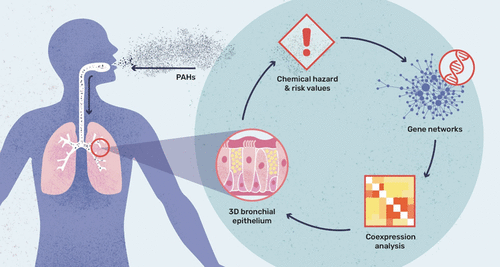当前位置:
X-MOL 学术
›
Chem. Res. Toxicol.
›
论文详情
Our official English website, www.x-mol.net, welcomes your feedback! (Note: you will need to create a separate account there.)
Linking Coregulated Gene Modules with Polycyclic Aromatic Hydrocarbon-Related Cancer Risk in the 3D Human Bronchial Epithelium
Chemical Research in Toxicology ( IF 4.1 ) Pub Date : 2021-05-28 , DOI: 10.1021/acs.chemrestox.0c00333 Yvonne Chang 1 , Julia E Rager 2, 3 , Susan C Tilton 1, 4
Chemical Research in Toxicology ( IF 4.1 ) Pub Date : 2021-05-28 , DOI: 10.1021/acs.chemrestox.0c00333 Yvonne Chang 1 , Julia E Rager 2, 3 , Susan C Tilton 1, 4
Affiliation

|
Exposure to polycyclic aromatic hydrocarbons (PAHs) often occurs as complex chemical mixtures, which are linked to numerous adverse health outcomes in humans, with cancer as the greatest concern. The cancer risk associated with PAH exposures is commonly evaluated using the relative potency factor (RPF) approach, which estimates PAH mixture carcinogenic potential based on the sum of relative potency estimates of individual PAHs, compared to benzo[a]pyrene (BAP), a reference carcinogen. The present study evaluates molecular mechanisms related to PAH cancer risk through integration of transcriptomic and bioinformatic approaches in a 3D human bronchial epithelial cell model. Genes with significant differential expression from human bronchial epithelium exposed to PAHs were analyzed using a weighted gene coexpression network analysis (WGCNA) two-tiered approach: first to identify gene sets comodulated to RPF and second to link genes to a more comprehensive list of regulatory values, including inhalation-specific risk values. Over 3000 genes associated with processes of cell cycle regulation, inflammation, DNA damage, and cell adhesion processes were found to be comodulated with increasing RPF with pathways for cell cycle S phase and cytoskeleton actin identified as the most significantly enriched biological networks correlated to RPF. In addition, comodulated genes were linked to additional cancer-relevant risk values, including inhalation unit risks, oral cancer slope factors, and cancer hazard classifications from the World Health Organization’s International Agency for Research on Cancer (IARC). These gene sets represent potential biomarkers that could be used to evaluate cancer risk associated with PAH mixtures. Among the values tested, RPF values and IARC categorizations shared the most similar responses in positively and negatively correlated gene modules. Together, we demonstrated a novel manner of integrating gene sets with chemical toxicity equivalence estimates through WGCNA to understand potential mechanisms.
更新日期:2021-06-21



























 京公网安备 11010802027423号
京公网安备 11010802027423号